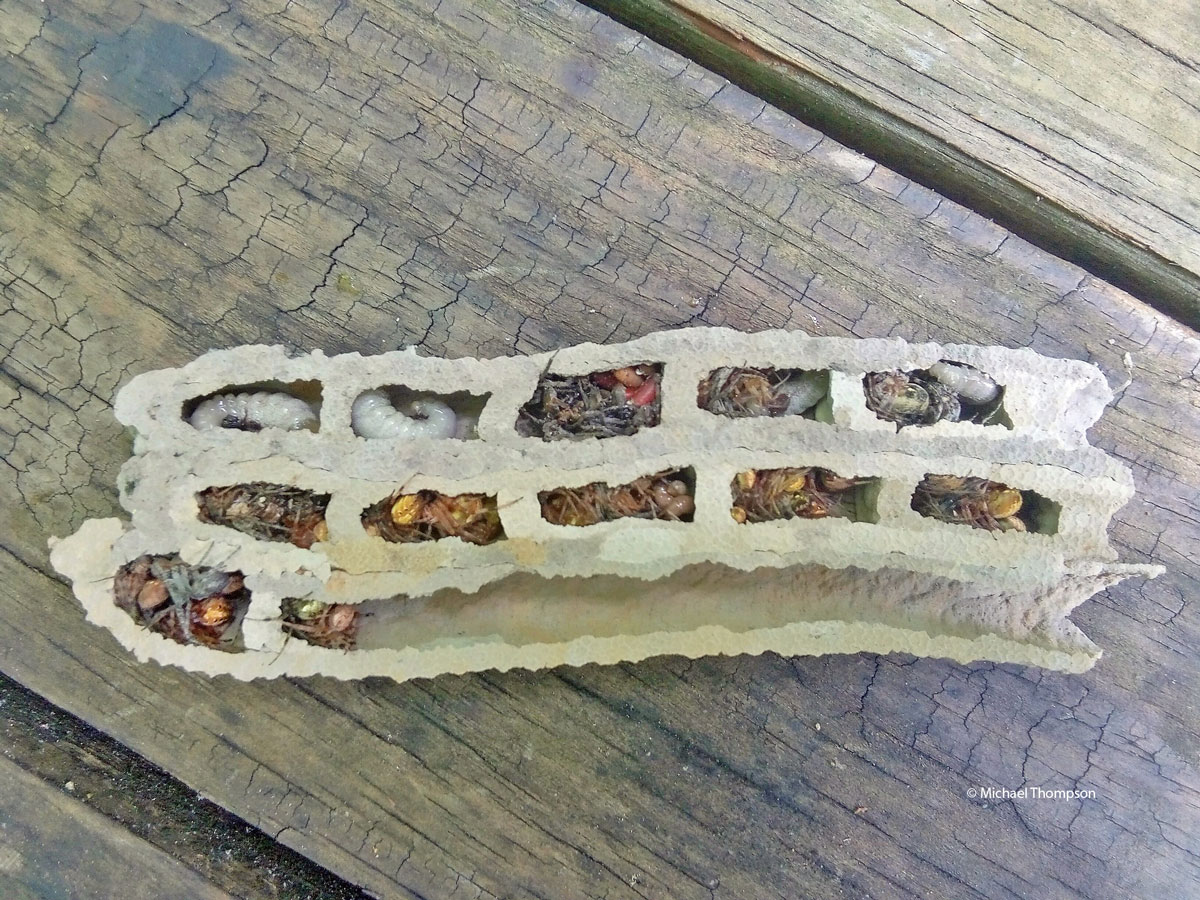Organ Pipe Mud Dauber, Vol. 8, No. 22

Trypoxylon politum
Order: Hymenoptera
Family: Crabronidae
Serendipity happens! Mr. Thompson was repairing a piece of equipment when he noticed this mud dauber nest had broken off the smooth covering to which it had been attached, remaining intact to provide a behind the scenes view of mud dauber biology. Let’s see what we can see.
This is the nest of the aptly named organ pipe mud dauber, rather than the equally common, black and yellow mud dauber, which builds shorter, more blocky mud nests. It was clearly the nest of a successful female because this was in mid-June and there were already eleven completed cells. To be this successful, she probably had a hard-working mate as well, to stay behind and guard the nest while she was out collecting mud and hunting spiders. Guarding the nest is a critical job, because other females will steal spiders or even take over unguarded nests, and there are smaller wasps that parasitize mud dauber larvae—if they can slip by the guard.
You can easily see the master plan here. Build a tube of dried mud; divide it into brood cells; stock each cell with spiders; deposit a single egg before sealing it; then move to the next cell. It is interesting to see she finished building the last tube (tubes are oriented vertically, with the opening at the bottom) before beginning to stock it with spiders and build individual cells. This is good time and resource management. If you are a mud dauber, you need to build while mud is available; you can still hunt spiders after mud sources dry up.
Check out cell number eleven, in the lower lefthand corner. It is packed with ten to twelve spiders, all orb weavers. There is an egg in there somewhere, but it probably has not hatched yet. Cell number twelve is in progress. She was probably out hunting more spiders when the nest fell.
Now jump to cell number one. No spiders left here; that big fat larva has eaten them all. But it has not yet pupated; neither has the larva in cell two. You can see the head of this larvae, curled back over the abdomen. Looks like something may have gone wrong in cell three. There is no sign of a larva and still a lot of spiders left, but healthy larvae are visible in cells four and five. Cells six through ten are packed with spiders and progressively younger larvae, with only the larva in cell eight visible.
These spiders are not dead. Female mud daubers paralyze their prey with a well-placed sting. The unlucky spiders remain alive until eaten by the larvae. Trypoxylon politum is not polite to orb weaver spiders. One wasp can kill a lot of spiders. Let’s see, twelve cells at ten to twelve spiders per cell…. that’s more than 120 spiders, and the female that built this nest probably started another one after she returned and found this one gone.
See Bug’s Eye View No. 20 of 2020 for additional information about
Organ Pipe Mud Daubers .
See Bug’s Eye View No. 21 of 2017, for a brief article on cicada killer wasps, which is the largest member of the mud dauber family.
Thanks to Mr. Michael Thompson for sharing this photo.
Blake Layton, Extension Entomology Specialist, Mississippi State University Extension Service.
The information given here is for educational purposes only. Always read and follow current label directions. Specific commercial products are mentioned as examples only and reference to specific products or trade names is made with the understanding that no discrimination is intended to other products that may also be suitable and appropriately labeled. Mississippi State University is an equal opportunity institution.
Bug’s Eye View is now on Facebook. Join the Bug's Eye View Facebook group here.

